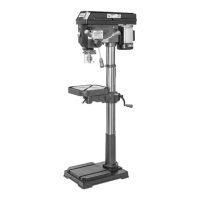-38-
Model T33903/T33904 (Mfd. Since 07/23)
Review the troubleshooting procedures in this section if a problem develops with your machine. If you need
replacement parts or additional help with a procedure, call our Technical Support.
Note: Please gather
the
serial number and manufacture date of your machine before calling.
SECTION 7: SERVICE
Troubleshooting
Motor & Electrical
Symptom Possible Cause Possible Solution
Machine does
not start, or
power supply
breaker
immediately
trips after
startup.
1. Switch disabling key removed.
2. Incorrect power supply voltage or circuit size.
3. Power supply circuit breaker tripped or fuse
blown.
4. Motor wires connected incorrectly.
5. Start capacitor at fault.
6. Centrifugal switch adjustment/contact points
at fault.
7. Wiring broken, disconnected, or corroded.
8. ON/OFF switch at fault.
9. Motor or motor bearings at fault.
1. Install switch disabling key.
2. Ensure correct power supply voltage and circuit size
(Page 13).
3. Ensure circuit is free of shorts. Reset circuit breaker
and replace fuse.
4. Correct motor wiring connections (Page 47).
5. Test/replace if at fault.
6. Adjust centrifugal switch/clean contact points. Replace
either if at fault.
7. Fix broken wires or disconnected/corroded
connections (Page 47).
8. Replace switch.
9. Replace motor.
Machine
stalls or is
underpowered.
1. Workpiece material unsuitable for machine.
2. Feed rate/cutting speed too fast.
3. Belt(s) slipping/pulleys misaligned.
4. Motor wires connected incorrectly.
5. Pulley slipping on shaft.
6. Machine undersized for task.
7. Motor overheated.
8. Run capacitor at fault.
9. Extension cord too long.
10. Centrifugal switch/contact points at fault.
11. Motor or motor bearings at fault.
1. Only cut wood with moisture below 20% and correct
type/size of metal.
2. Decrease feed rate/cutting speed (Page 29).
3. Clean/tension/replace belt(s) (Page 29); ensure
pulleys are aligned (Page 42).
4. Correct motor wiring connections (Page 47).
5. Tighten/replace loose pulley/shaft.
6. Use sharp bits/reduce feed rate/reduce spindle RPM
(Page 29).
7. Clean motor, let cool, and reduce workload.
8. Test/repair/replace.
9. Move machine closer to power supply; use shorter
extension cord (Page 14).
10. Adjust centrifugal switch/clean contact points. Replace
either if at fault.
11. Replace motor.
Machine has
vibration or
noisy operation.
1. Motor or component loose.
2. V-belt(s) worn, loose, pulleys misaligned or
belt slapping cover.
3. Pulley loose.
4. Motor mount loose/broken.
5. Spindle loose, improperly installed or
damaged.
6. Workpiece loose.
1. Replace damaged or missing bolts/nuts or tighten if
loose.
2. Inspect/replace belts with a new matched set (Page
29). Realign pulleys if necessary (Page 42).
3. Secure pulley on shaft.
4. Tighten/replace.
5. Tighten loose spindle, re-install spindle ensuring
mating surfaces are clean, replace spindle if damaged.
6. Usecorrectholdingxtureandreclampworkpiece.

